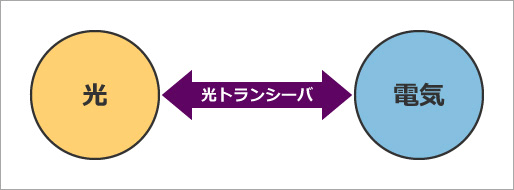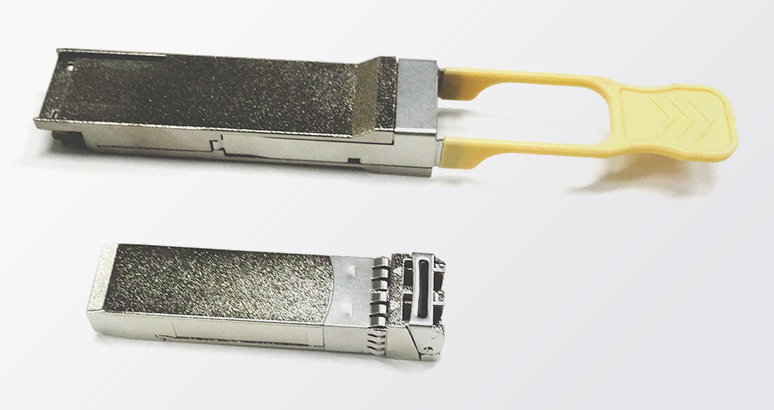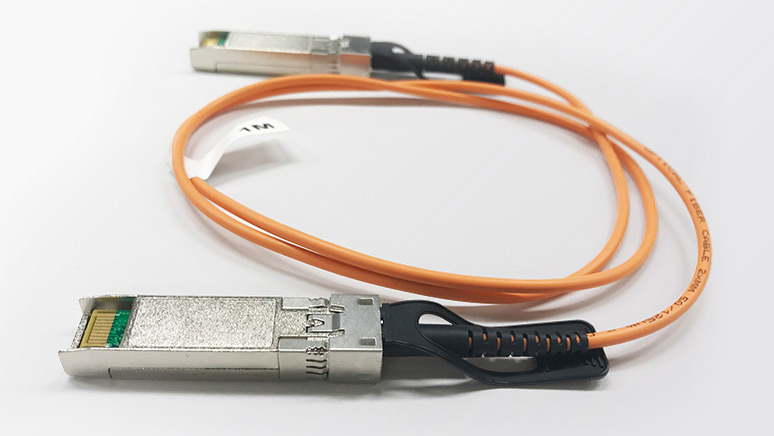Data centers where high-speed optical transmission technology is essential
The data center market has grown exponentially in recent years. In particular, as bandwidth increases in data networks, the speed of optical transceiver modules that connect devices in data centers is increasing.
In this article, we will introduce what an optical transceiver module is for beginners who want to learn about optical transceiver modules.
What is an optical transceiver module?
An optical transceiver module is a device for converting electrical signals and optical signals to each other as shown in the figure below.

Here, we will explain what an "optical transceiver module" is by dividing it into the following four points.
- Types of optical transceiver modules
- Interface to access the optical transceiver module
- Optical fiber type
- Relationship between standard and distance
1. Types of optical transceiver modules
The table below shows the optical transceiver modules corresponding to each transmission speed.
SFP/QSFP is backward compatible, for example, in case of SFP28 cage, all SFP (SFP, SFP+) can be inserted. Of course, QSFP+ is inserted into the cage of QSFP28, and QSFP28 and QSFP+ are also inserted into QSFP-DD. However, please note that CFP is not compatible.
| 10G | 25G | 40G | 50G | 100G | 200G | 400G | |
| SFPs | SFP+ | SFP28 | - | SFP56 | SFP-DD | - | - |
| QSFP | - | - | QSFP+ | - | QSFP28 | QSFP56 | QSFP-DD |
| OSFP | - | - | - | - | - | - | OSFP |
| CFP | - | - | CFP | - | CFP CFP2 CFP4 |
- | CFP8 |
Also, the size of the optical transceiver module is as follows when focusing on 100G/400G. I hope you can see it for reference.
| 100G module | 400G module | |||||||
| CFP | CFP2 | CFP4 | QSFP28 | CFP8 | QSFP | QSFP-DD | ||
| Front of equipment | W | 14.50mm | 16.00mm | 16.00mm | 20.00mm | 16.00mm | 20.98mm | 20.00mm |
| D | 82.00mm | 42.50mm | 22.10mm | 19.00mm | 40.80mm | 22.93mm | 19.00mm | |
| Equipment inside (PCB side) | W | 75.00mm | 41.50mm | 21.50mm | 18.35mm | 40.00mm | 22.58mm | 18.35mm |
| D | 130.25mm | 91.50mm | 76.00mm | 52.40mm | 86.00mm | 79.42mm | 58.26mm | |
| H | 13.60mm | 12.40mm | 9.50mm | 8.50mm | 9.50mm | 13.00mm | 8.50mm | |

2. Interface to access the optical transceiver module
SFP/QSFP is I2C interface and CFP is MDIO interface. Serial ID and TX_FAULT/RX_LOS information can be checked externally through these interfaces.
3. Optical fiber type
There are three main types of optical fiber.
MMF (Multi-Mode fiber)
MMF can transmit optical signals in multiple modes. However, dispersing the mode causes data loss, so it is not suitable for long-distance or high-speed transmission, but it is cheap.
SMF (Single-Mode fiber)
SMF is more expensive than MMF, but it is suitable for long-distance, high-speed transmission. Since the optical signal propagates in a single mode, signal attenuation can be suppressed. Also, since there is only one time of arrival for the signal, there is no data loss due to modal dispersion.
AOC (Active Optical Cable)
AOC is an integrated optical transceiver module and optical fiber cable as shown in the photo below. In the table below, "AOC (MMF)" indicates that the optical transceiver module and MMF fiber are integrated.

4. Relationship between standard and distance
The fiber used in the optical transceiver module is determined for each standard, and the transmission distance changes depending on which standard is used. Below are the approximate transmission distances based on the 40GE/100GE/200GE/400GE standards and fiber types. We would appreciate it if you could use it as a reference for selection.
| application | standard | fiber | distance |
| 40GE | 40GBASE-SR4 | MMF | 100m |
| 40GBASE-FR | SMF | 2km | |
| 40GBASE-LR4 | SMF | 10km | |
| 40GBASE-ER4 | SMF | 40km | |
| 100GE | 100GBASE-SR10 | MMF | 100m |
| 100GBASE-LR4 | SMF | 10km | |
| 100GBASE-SR4 | MMF | 700m | |
| 100GBASE-ER4 | SMF | 40km | |
| 200GE | 200GBASE-DR4 | SMF | 500m |
| 200GBASE-FR4 | SMF | 2km | |
| 200GBASE-LR4 | SMF | 10km | |
| 400GE | 400GBASE-DR4 | SMF | 500m |
| 400GBASE-FR8 | SMF | 2km | |
| 400GBASE-LR8 | SMF | 10km | |
| 400GBASE-SR8 | AOC(MMF) | 100m | |
| 400GBASE-FR4 | SMF | 2km |
Click here for information on testing methods for optical transceiver modules
What did you think. We also offer measuring equipment and evaluation jigs for measuring optical transceiver module systems.
If you want to learn more about what you need for the exam and how to use your test equipment to troubleshoot network problems, check out the articles below.
Items required for testing optical transceivers
Solving Network Problems Using Measuring Instruments Episode 1 Understanding the Importance of Interoperability Testing
Contact Us
We handle optical transceiver modules made by II-VI (former Finisar). If you have any questions about price, delivery time, or selection, please feel free to contact us.
